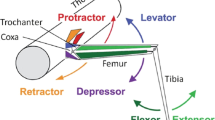Abstract
Catalepsy in the femur-tibia joint can be characterized as follows: When the joint is passively bent and then released, the joint first extends rapidly by 10°–30° and then returns to its starting position with extremely low speed.
Catalepsy is a characteristic of the femur-tibia control system. This system is quantitatively described in the open-loop configuration (input: stimulation of the femoral chordotonal organ; output: movement of the tibia). The output shows a predominant dynamic portion which only responds to movement and a weak static portion which responds to position. The dynamic portion can be described by a high-pass and a low-pass filter in series. The time constant of the high-pass filter in series. The time constant of the high-pass filter depends on input slope. The system possesses a large phase reserve and is therefore very stable in the closed loop configuration.
The results confirm the hypothesis that the high gain of the phasmid control system evolved only under a selection pressure towards catalepsy.
Similar content being viewed by others
References
Bässler, U.: Propriorezeptoren am Subcoxal- und Femur-Tibia-Gelenk der Stabheuschrecke Carausius morosus und ihre Rolle bei der Wahrnehmung der Schwerkraftrichtung. Kybernetik2, 168–193 (1965)
Bässler, U.: Der “Kniesehnenreflex” bei Carausius morosus: Übergangsfunktion und Frequenzgang. Kybernetik11, 32–50 (1972)
Bässler, U.: Vom femoralen Chordotonalorgan gesteuerte Reaktionen bei der Stabheuschrecke Carausius morosus: Messung der von der Tibia erzeugten Kraft im aktiven und inaktiven Tier. Kybernetik16, 213–226 (1974)
Bässler, U.: Neural basis of elementary behavior in stick insects. Berlin, Heidelberg, New York: Springer 1982a (in press)
Bässler, U.: The neural basis of catalepsy in the stick insect Cuniculina impigra. 3. Characteristics of the extensor motor neurons. In preparation (1982b)
Bässler, U., Pflüger, H.-J.: The control system of the femur-tibia joint of the phasmid Extatosoma tiaratum and the control of rocking. A contribution to the evolution of behaviour. J. Comp. Physiol.132, 209–215 (1979)
Bässler, U., Storrer, J., Saxer, K.: The neural basis of catalepsy in the stick insect Cuniculina impigra. 2. The role of the extensor motor neurons and the characteristics of the extensor muscle. In preparation (1982)
Ebner, I., Bässler, U.: Zur Regelung der Stellung des Femur-Tibia-Gelenkes in Mesothorax der Wanderheuschrecke Schistocerca gregaria. Biol. Cybern.29, 83–96 (1978)
Author information
Authors and Affiliations
Additional information
Supported by DFG Ba 578
Rights and permissions
About this article
Cite this article
Bässler, U., Foth, E. The neural basis of catalepsy in the stick insect cuniculina impigra. Biol. Cybern. 45, 101–105 (1982). https://doi.org/10.1007/BF00335236
Received:
Issue Date:
DOI: https://doi.org/10.1007/BF00335236




